
Today seems like a good day to pick a fight. So, let us jump in and talk about oil catch cans and PCV systems on modern gas engines, and more specifically, the Gen 3 Hemi. The catch can debate is one that has been raging online among all the “Experts” for decades.
PCV, not PVC, refers to Positive Crankcase Ventilation. Does your car have this “system”? The answer would be “Yes”, more than likely, unless you drive a classic. Let us clarify something here, positive crankcase ventilation is a requirement for almost every gas powered combustion engine found in cars. But how it is utilized in modern days is what could be harming your engine.
Above Left: Billet Technologies Hemi catch can on a Hellcat, Above Right: side view of Billet Technologies catch can.
In case you are unaware, when an engine is running, and the piston is forced downward from the combustion process, an unavoidable amount of air/fuel/gases makes it past the piston rings which “seal” the cylinder chamber. This mix of air/fuel/gases is a result of the pressure created from the combustion/explosion.
It gets forced into the crankcase and this is called blow-by. To combat this pressure inside the crankcase, they developed a vent for it to vent out the pressure or keep an even pressure inside the crankcase. Things get even more interesting when you add in boost pressure from a turbo or supercharger. For every approximately 14.5psi of boost you are in a sense, doubling the size of the engine’s displacement.

Above: Catch Can is most commonly mounted to a stud on the water pump cover.
Inside the crankcase lives lots and lots of motor oil. So all this blow-by forced into the crankcase gets vented, along with it comes some oil. In the early days, they used what was called a draft tube.
Basically a tube that attached to the motor where this vent was, and it ran down to the bottom of the engine bay under the car. The draft of air under the car while you were driving whisked away the oil from the tube and straight under the car on to the road. Also common on older cars you would find breather caps on the valve covers or rubber plugs with a vacuum line running to the carburetor.
Above Left: Remote mounted on PCM bracket on Grand Cherokee/Durango. Above Right: System works the same and can be mounted anywhere with additional hose.
Eventually we figured out that this was not the most environmentally friendly or efficient way to go about dealing with blow-by gases and oil. So “we” developed a new way to process this pressure and escaped oil. The quickest, cheapest, and easiest way to solve the issue was to feed this vent right back into the motor.
Alright, that sort of makes sense. Keep the gases and oil inside the motor where they belong. Well, once you realize where it feeds back in is where it starts to make less sense. It just so happens that that majority of the time this goes directly into your intake tract, intake manifold, intake inlet tube or throttle body. Often one side of the system is connected via a small hose to the air intake tube which helps put the system into a vacuum.

Above: Dual Catch Can often used on Hellcat/Demon/Redeye. Notice the secondary can is much smaller.
The other side of the system has a one-way valve which lets pressure escape where it is then fed into your intake. On the Gen 3 Hemi engines, depending on which one you have, we generally have a PCV one way valve on the passenger side of the valve cover or intake manifold. It generally mates to a small vacuum hose which then feeds over to the inlet (throttle body) side of the intake manifold. On the supercharged Hellcat/Redeye platform it feeds back in at the bottom of the supercharger inlet snout.
Blowing motor oil into your intake system sounds like a great idea, right? Well, depending on your car and where it feeds back in, it can gunk up your throttle body, your intake tube and resonator, your entire intake manifold, supercharger, intake manifold gaskets, and more. From there, no matter what, it makes it eventually makes its way back into your cylinder.
Oil inside the cylinder is bad. It gets burnt in the combustion process. That itself is not really a big deal. You will burn a little oil and therefor loose a little oil. If it was vented to the atmosphere like in the old days, you were still losing oil.
Above Left : Inlet of PCV/Catch Can into supercharger snout on 6.2L engines. Above Right: Passenger-side PCV outlet on valve cover- note the specialty fitting required on 6.2L engines.
So, the problem is on modern fuel injected and computer-controlled motors is that it can really ruin the performance of your motor. Oil being burnt in the combustion process can cause detonation, which is generally something you want to avoid.
Detonation can cause knock, which is also not something you want to make friends with. When cars knock sensors pick up knock, they don’t necessarily have a way to know what is causing it, other than that it is there. When knock is detected the engines computer will start to pull out timing and fuel to limit power as a form of self-protection.
Knock sensors are looking for pre detonation which can be a critical condition that could blow your engine. The oil coming out of PCV system and making its way into the combustion chamber is not going to cause a critical running condition with your engine. It can however, cause knock, which will degrade the performance of your hot rod.
Above Left: Driver-side PCV outlet on valve cover found on 2018+ which also has an integrated sensor. Above Right: 2018+ PCV solenoid on driver-side circuit.
So, you are wondering how can you do something about this? If you have not heard before, there is an item called a catch can. Some refer to it as an oil separator or oil catch can. It’s simple really, and lots of people use them on performance builds. However, we are in favor of any enthusiast using them no matter how much or how little horsepower your car has and regardless of if you race or track your car. We even threw one on our Project Jeep Trail ’n Thrash seen here.
There are hundreds of variations from generic-fits-all to vehicle specific. But they all work on the same principal. It gets inserted between the outlet of the PCV valve where the pressure (and unwanted oil) exits the motor. One side is connected to the PCV outlet, and the other side feeds into your intake system. You are just installing a component between the system that already exists.
Above Left: 6.1L Hemi PCV connection points. Above Right: Catch Can installed on a 6.1L Hemi.
A good catch can has a media of some sort in the top portion of the can. A lot of times this material is something like steel wool. It works like how a catalytic converter works. It creates surface area for oil and gunk to stick to.
The PCV hose attaches from the PCV valve on the motor to the top of the catch can. The air passes across the steel wool/mesh/screen in the top, and goes out the other side of the top of the catch can. The unwanted oil gets caught in the filter and eventually drops to the bottom of the can.

Above: 6.2L Hemi PCV connection points.
It is basically a trap for that unwanted oil. You empty the can regularly (we do ours at oil change, and once in between) to keep it from over filling. If it overfills, you are defeating the purpose and just blowing oil into your cylinders again. Other than the periodic emptying, it is pretty maintenance free and easy to install.
We know you are thinking that this is snake oil. We can assure you that it is not. We have removed hundreds of Gen 3 HEMI intake manifolds, throttle bodies, superchargers, and air intakes. Feel free to ask anyone else who has as well. Even on low mileage cars (under 5000 miles) you will find oil pooled into the bottom of the manifold or supercharger.

Above: 6.4L Hemi PCV connection points.
Where else would oil come from between the air intake and the intake manifold when the only other circuit is the PCV circuit? Take a look at the intake manifold gasket on any Gen 3 hemi that has some miles on it, and if the engine doesn’t have a catch can on it, we promise you that you will see a nice oil-soaked, gunk-covered, hanging-on-for-dear-life manifold gasket.
Even the all-mighty Hellcat suffers from the same issue, which uses metal gaskets with integrated rubber seals. You can install a Catch Can yourself and see within just a few hundred miles that oil will start to collect. The only place that oil was headed was back into your motor.
Above Left: Filtering media in top of Catch Can. Above Right: Oil collection over 4000 miles on Hellcat engine with 20K miles.
The 5.7, 6.1, and 6.4 Gen 3 HEMI motors generally just had one PCV outlet on the passenger side of the motor. The Hellcat motors have one on each side of the motor. The line off the passenger-side goes into the supercharger snout, and the driver-side line goes into the top of the intake tube.
In 2018 Dodge revised the system to include a solenoid on the driver-side circuit that opens and closes with boost to keep the circuit in a vacuum. Truth be told, there isn’t a large amount of oil making its way out through the driver side. If you are on a budget or lack of room in your engine bay, you could skip the driver-side and still be just fine.
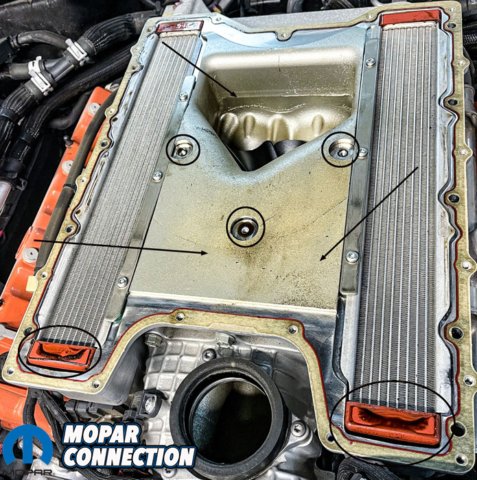
Above: Oil build-up inside supercharger of 1300 mile Hellcat engine.
If it’s something that is really that helpful, why didn’t Dodge put it on there? Altering the PCV circuit, which is technically part of the emissions system, is wrapped with TONS of red tape. The dealer can’t even change the TPMS thresholds anymore.
So please do your engine a favor and get yourself a catch can for your Gen 3 Hemi. You can order one from Mancini Racing, American Muscle, Summit Racing, etc. After your car burns up what oil is in the system from years of neglect it will thank you.
Above Left: Oil build-up inside supercharger lid of 1300 mile Hellcat engine. Above Right: Oil build-up in the intake ports of cylinder heads on 3000 mile Hellcat engine.
You might see better performance and at minimal, you will be protecting your engine from the harmful effects of crankcase ventilation recirculation. You should see a longer lifespan on spark plugs and gaskets.
One small tip before we head out for a rip around the block: The Hellcat platform requires a specific connector type for the PCV outlet fitting so look for a kit designed for the Hellcat. The other Gen 3 motors will generally just require heater hose with no specific connectors or adapters.

Above: Oil pooled in bottom of supercharger on 1300 mile Hellcat engine.
Install is quick and easy. Depending on your engine, start by locating the OEM PCV line, as shown in the photos. Carefully use a pry tool to remove the hose on the 5.7, 6.1, 6.4 motors. The 6.2L motors have a special fitting on each end. The fitting on the valve cover has a small tab on the side, slide tab over with one hand and use pry tool to pry up on fitting with other hand. The fitting on the supercharger side has a button you depress while prying.
Above Left: Hellcat valve cover fitting. Above Right: Hellcat supercharger fitting.
Depending on the brand catch can you purchased, mount catch can in its designated position based on manufacturer’s instructions. Attach your hoses to each side of the catch can and to the inlet and outlet of the PCV ports. Make sure hoses are clear of any moving parts such as fans or belts. Avoid sharp bends or turns in the hose that may result in a kink in the line. Now go drive and don’t forget to empty the oil with your normal scheduled maintenance.









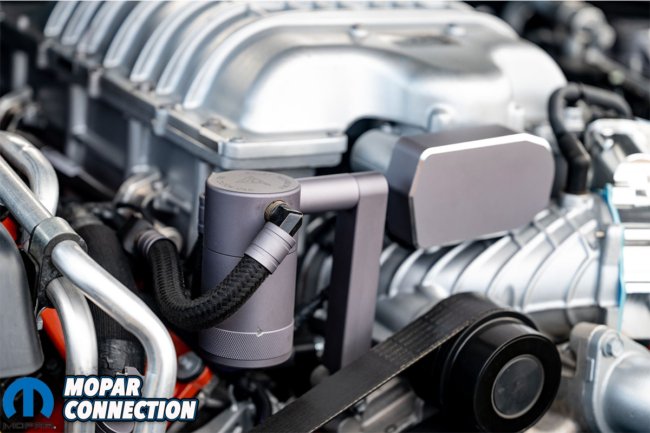


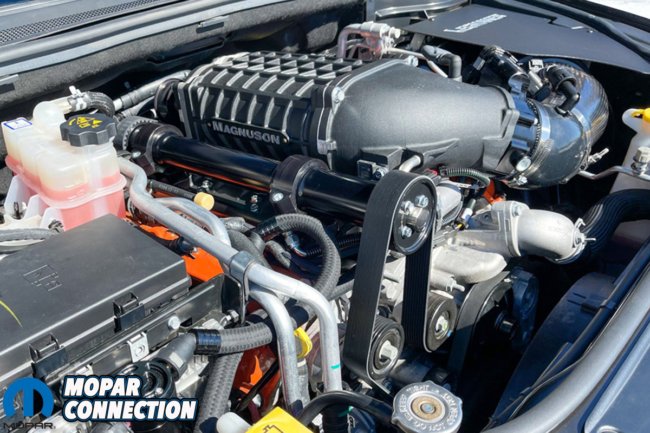
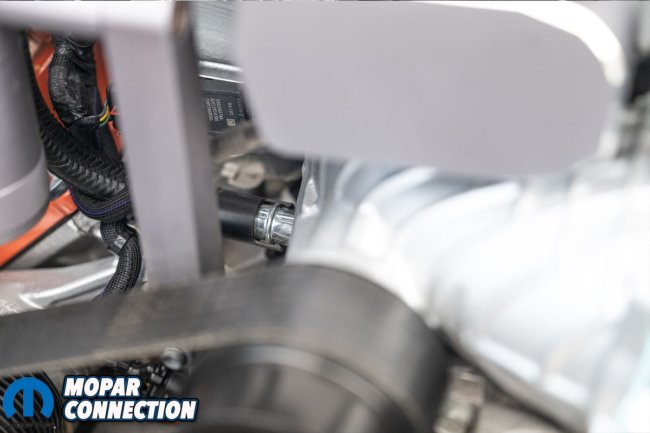

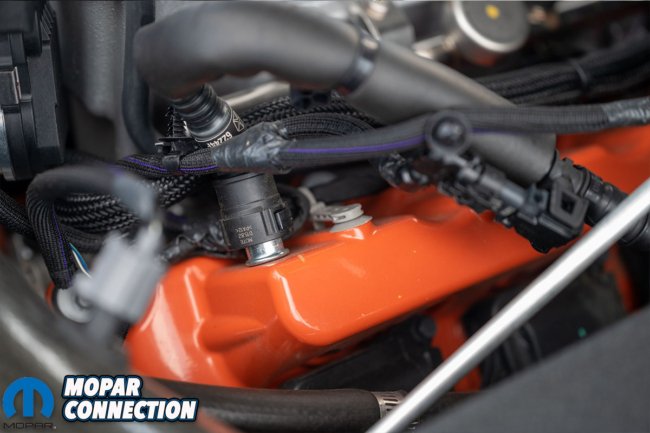
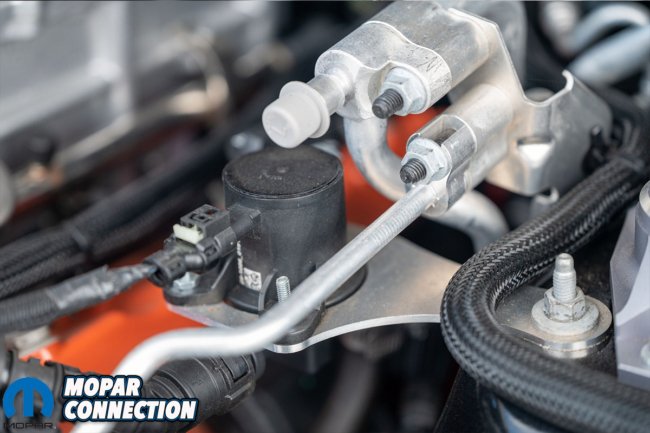


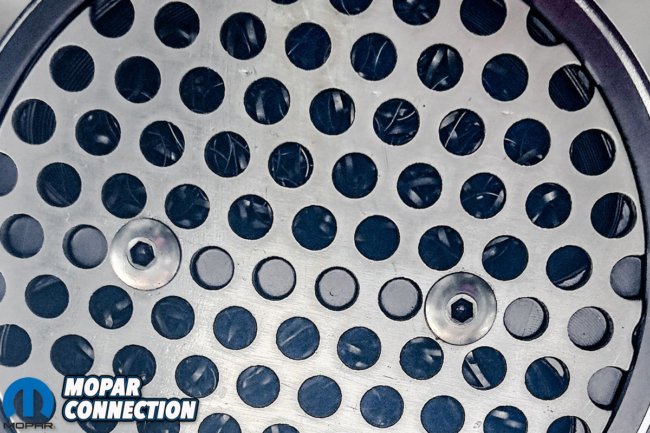
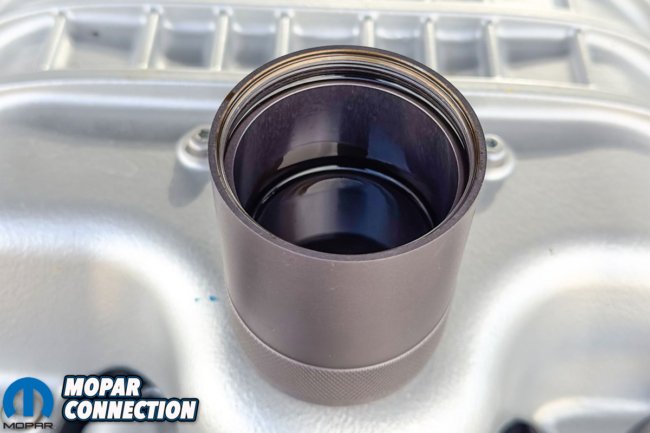
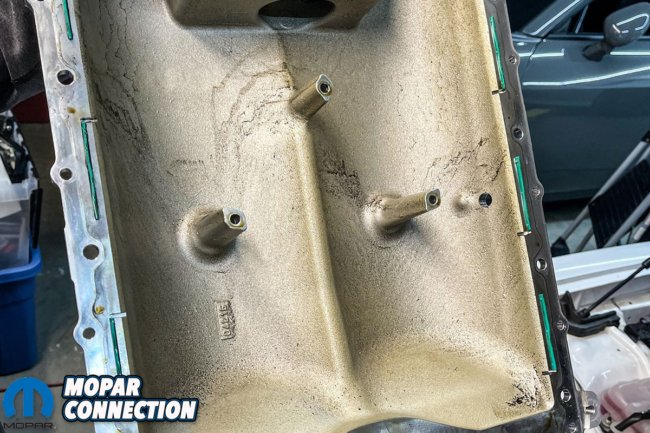
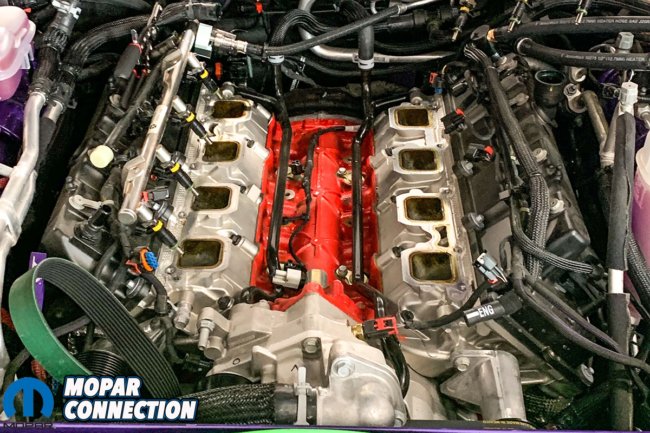






 Mopar Connection Magazine – The ONLY Daily Mopar Magazine © 2022. All Rights Reserved. Mopar Connection Magazine is the ONLY daily Mopar Magazine bringing you the latest Mopar news, technology, breaking news, and Mopar related events and articles. Find out the latest information about Mopar, Mopar products and services, stay up to date on Mopar enthusiast news, dealership information and the latest Mopar social media buzz! Sign up for the Mopar Connection Magazine newsletter for the latest information about new products, services and industry chatter. Mopar Connection Magazine is the best and only source you need to be a Mopar industry insider!
Mopar Connection Magazine – The ONLY Daily Mopar Magazine © 2022. All Rights Reserved. Mopar Connection Magazine is the ONLY daily Mopar Magazine bringing you the latest Mopar news, technology, breaking news, and Mopar related events and articles. Find out the latest information about Mopar, Mopar products and services, stay up to date on Mopar enthusiast news, dealership information and the latest Mopar social media buzz! Sign up for the Mopar Connection Magazine newsletter for the latest information about new products, services and industry chatter. Mopar Connection Magazine is the best and only source you need to be a Mopar industry insider! by
by